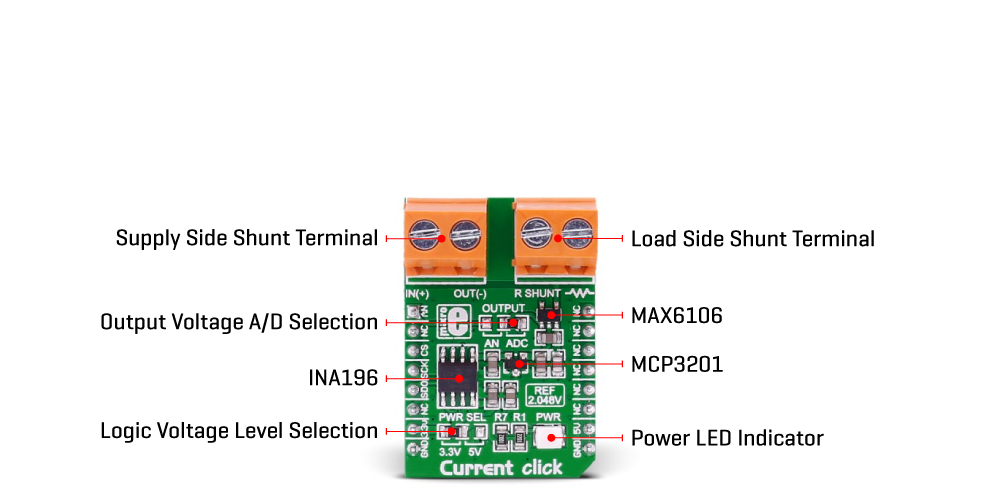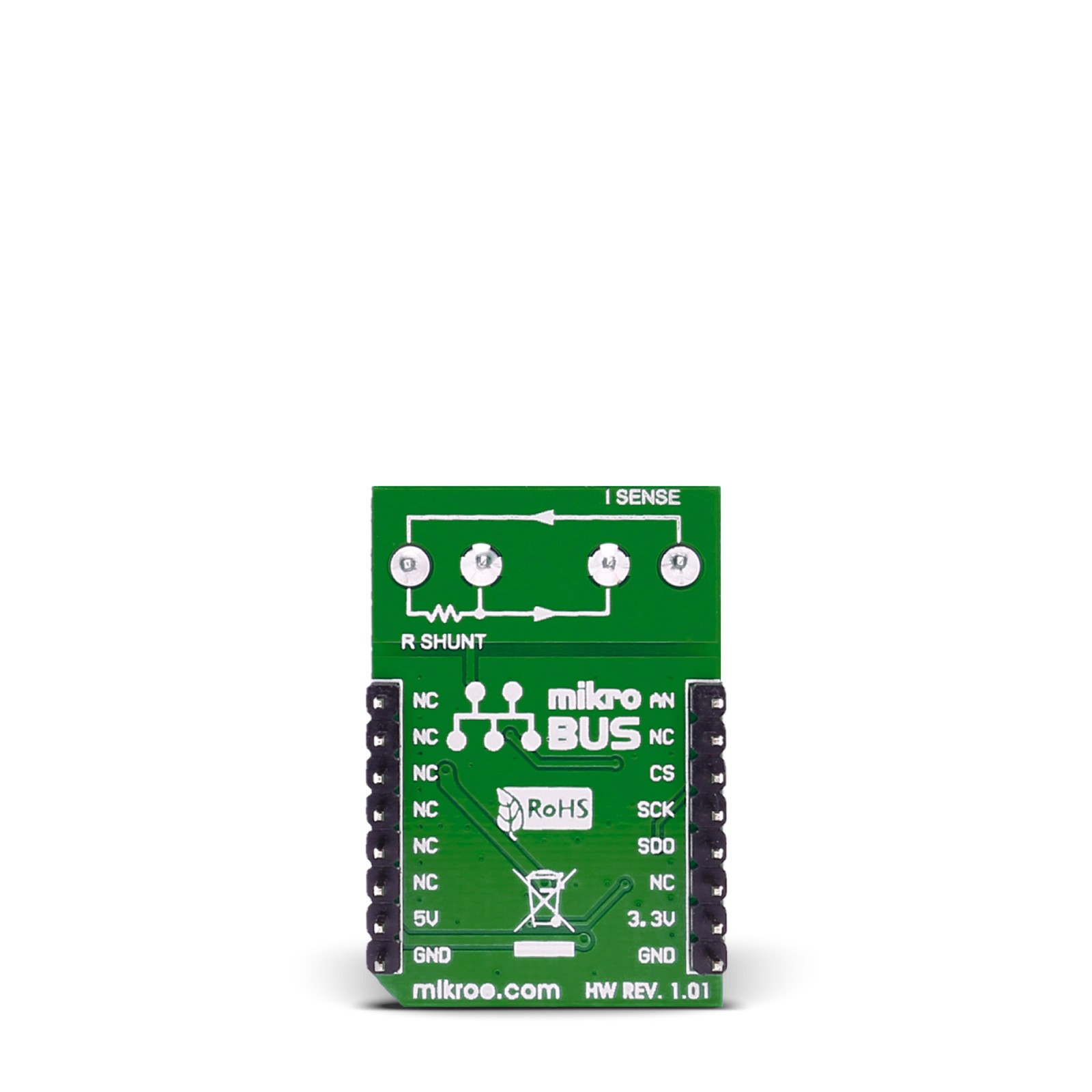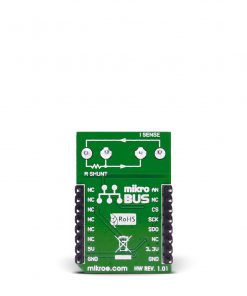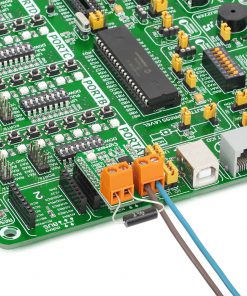Current Click
R765.00 R305.00 ex. VAT
Current Click is a compact add-on board providing a complete current sensing solution. This board features the INA196, a current shunt monitor from Texas Instruments. The INA196 has voltage output that can sense drops across shunts at common-mode voltages from −16V to +80V, independent of its supply voltage. To measure current values in various bands, users need to provide the shunt of the appropriate value allowing the measurement in the range of 2-2048mA, depending on chosen shunt resistor. After that, the user is allowed to process measurements in analog or digital form. It is also characterized by a gain of 20V/V and 500kHz bandwidth, simplifying current control loops’ use. This Click board™ is ideal for high-accuracy current measurements for many consumer, enterprise, telecom, and automotive applications.
Current Click is supported by a mikroSDK compliant library, which includes functions that simplify software development. This Click board™ comes as a fully tested product, ready to be used on a system equipped with the mikroBUS™ socket.
Stock: 1 available immediately.
How does it work?
Current Click is based on the INA196, a current shunt monitor from Texas Instruments. The INA196 has voltage output that can sense drops across shunts at common-mode voltages from −16V to +80V, independent of its supply voltage. It is also characterized by a gain of 20V/V and 500kHz bandwidth, simplifying current control loops’ use across wide temperature range, making it suitable for many consumer, enterprise, telecom, and automotive applications.

This Click board™ measures current values in various bands. The board receives current from the output circuit connected to IN(+) and OUT(-) pins of the first screw terminal, where the INA196 converts this current into a voltage, while the second screw terminal is used for the external shunt connection. Users need to provide the shunt of the appropriate value allowing the measurement up to 2048mA, based on the reference voltage set by MAX6106. For that reason, four shunts with different values are provided in the package (0.05, 0.2, 1, and 10Ω).
The output signal of the INA196 can be converted to a digital value using MCP3201, a successive approximation A/D converter with a 12-bit resolution from Microchip using a 3-wire SPI compatible interface, or can be sent directly to an analog pin of the mikroBUS™ socket labeled as AN. Selection can be performed by onboard SMD jumper labeled as OUTPUT, placing it to an appropriate position marked as AN or ADC.
This Click board™ can operate with both 3.3V and 5V logic voltage levels selected via the PWR SEL jumper. This way, it is allowed for both 3.3V and 5V capable MCUs to use the communication lines properly. However, the Click board™ comes equipped with a library containing easy-to-use functions and an example code that can be used, as a reference, for further development.
Specifications
Type
Current sensor,Measurements
Applications
Can be used for high-accuracy current measurements for many consumer, enterprise, telecom, and automotive applications
On-board modules
INA196 – current shunt monitor from Texas Instruments
Key Features
Low power consumption, high bandwidth up to 500kHz, low total error output, high accuracy and precision, possibility of signal processing in analog and digital form, and more
Interface
Analog,SPI
Feature
No ClickID
Compatibility
mikroBUS™
Click board size
M (42.9 x 25.4 mm)
Input Voltage
3.3V or 5V
Pinout diagram
This table shows how the pinout on Current Click corresponds to the pinout on the mikroBUS™ socket (the latter shown in the two middle columns).
Onboard settings and indicators
| Label | Name | Default | Description |
|---|---|---|---|
| LD1 | PWR | – | Power LED Indicator |
| JP1 | PWR SEL | Left | Logic Level Voltage Selection 3V3/5V: Left position 3V3, Right position 5V |
| JP2 | OUTPUT | Right | Output Voltage A/D Selection AN/ADC: Left position AN, Right position ADC |
Current Click electrical specifications
| Description | Min | Typ | Max | Unit |
|---|---|---|---|---|
| Supply Voltage | 3.3 | – | 5 | V |
| Common-Mode Voltage Range | -16 | 12 | +80 | V |
| Current Measurement Range | – | – | 2048 | mA |
| Gain | – | 20 | – | V/V |
| ADC Resolution | – | 12 | – | bit |
Software Support
We provide a library for the Current Click as well as a demo application (example), developed using MikroElektronika compilers. The demo can run on all the main MikroElektronika development boards.
Package can be downloaded/installed directly from NECTO Studio Package Manager(recommended way), downloaded from our LibStock™ or found on Mikroe github account.
Library Description
This library contains API for Current Click driver.
Key functions
- Function is used to calculate current in mA.
Example Description
This is an example that shows the capabilities of the Current click board by measuring current in miliampers. Current click board can be used to safely measure DC current in the range of 2-2048mA depending on shunt resistor.
void application_task ( void )
{
curr = current_get_current_data( ¤t, CURRENT_RSHUNT_0_05 );
if ( curr == CURRENT_OUT_OF_RANGE )
{
log_printf( &logger, "Out of range!rn" );
}
else
{
log_printf( &logger, " Current: %.2f mArn", curr );
}
log_printf( &logger, "-----------------------rn" );
Delay_ms( 1000 );
}
The full application code, and ready to use projects can be installed directly from NECTO Studio Package Manager(recommended way), downloaded from our LibStock™ or found on Mikroe github account.
Other Mikroe Libraries used in the example:
- MikroSDK.Board
- MikroSDK.Log
- Click.Current
Additional notes and informations
Depending on the development board you are using, you may need USB UART click, USB UART 2 Click or RS232 Click to connect to your PC, for development systems with no UART to USB interface available on the board. UART terminal is available in all MikroElektronika compilers.
mikroSDK
This Click board™ is supported with mikroSDK – MikroElektronika Software Development Kit. To ensure proper operation of mikroSDK compliant Click board™ demo applications, mikroSDK should be downloaded from the LibStock and installed for the compiler you are using.
For more information about mikroSDK, visit the official page.
Resources
Downloads
| Weight | 40 g |
|---|---|
| Brand | MikroElektronika |

















